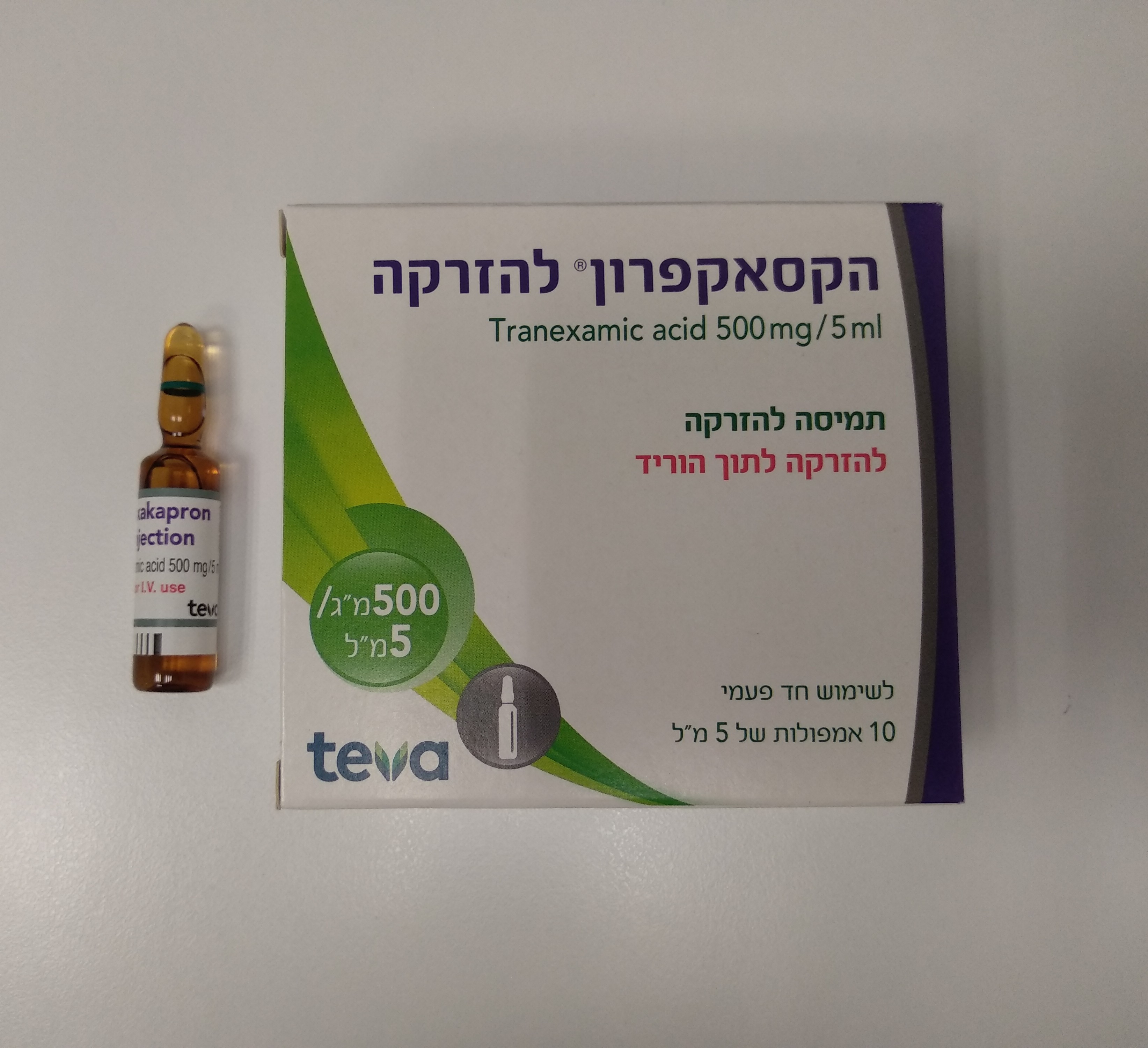Quest for the right Drug

הקסאקפרון להזרקה HEXAKAPRON INJECTION (TRANEXAMIC ACID)
תרופה במרשם
תרופה בסל
נרקוטיקה
ציטוטוקסיקה
צורת מתן:
תוך-ורידי : I.V
צורת מינון:
תמיסה להזרקה : SOLUTION FOR INJECTION
עלון לרופא
מינוניםPosology התוויות
Indications תופעות לוואי
Adverse reactions התוויות נגד
Contraindications אינטראקציות
Interactions מינון יתר
Overdose הריון/הנקה
Pregnancy & Lactation אוכלוסיות מיוחדות
Special populations תכונות פרמקולוגיות
Pharmacological properties מידע רוקחי
Pharmaceutical particulars אזהרת שימוש
Special Warning עלון לרופא
Physicians Leaflet
Pharmacological properties : תכונות פרמקולוגיות
Pharmacodynamic Properties
5.1 Pharmacodynamic properties Pharmacotherapeutic group: Antihemorrhagics, Antifibrinolytics, Aminoacids ATC code: B02A A02 Mechanism of action Tranexamic acid exerts an anti haemorrhagic activity by inhibiting the fibrinolytic properties of plasmin. A complex involving tranexamic acid, plasminogen is constituted; the tranexamic acid being linked to plasminogen when transformed into plasmin. The activity of the tranexamic acid-plasmin complex on the activity on fibrin is lower than the activity of free plasmin alone. In vitro studies showed that high tranexamic dosages decreased the activity of complement. Paediatric population In children over one year old: Literature review identified 12 efficacy studies in paediatric cardiac surgery which have included 1073 children, 631 having received tranexamic acid. Most of them were controlled versus placebo. Studied population was heterogenic in terms of age, surgery types, dosing schedules. Study results with tranexamic acid suggest reduced blood loss and reduced blood product requirements in paediatric cardiac surgery under cardiopulmonary bypass (CBP) when there is a high risk of haemorrhage, especially in cyanotic patients or patients undergoing repeat surgery. The most adapted dosing schedule appeared to be: - first bolus of 10 mg/kg after induction of anaesthesia and prior to skin incision, - continuous infusion of 10 mg/kg/h or injection into the CPB pump prime at a dose adapted on the CPB procedure, either according to patient weight with a 10 mg/kg dose, either according to CPB pump prime volume, - last injection of 10 mg/kg at the end of CPB. While studied in very few patients, the limited data suggest that continuous infusion is preferable, since it would maintain therapeutic plasma concentration throughout surgery. No specific dose-effect study or PK study has been conducted in children.
Pharmacokinetic Properties
5.2 Pharmacokinetic properties Absorption Peak plasma concentrations of tranexamic acid are obtained rapidly after a short intravenous infusion after which plasma concentrations decline in a multi-exponential manner. Distribution The plasma protein binding of tranexamic acid is about 3% at therapeutic plasma levels and seems to be fully accounted for by its binding to plasminogen. Tranexamic acid does not bind to serum albumin. The initial volume of distribution is about 9 to 12 liters. Tranexamic acid passes through the placenta. Following administration of an intravenous injection of 10 mg/kg to 12 pregnant women, the concentration of tranexamic acid in serum ranged 10-53 µg/mL while that in cord blood ranged 4-31 µg/mL. Tranexamic acid diffuses rapidly into joint fluid and the synovial membrane. Following administration of an intravenous injection of 10 mg/kg to 17 patients undergoing knee surgery, concentrations in the joint fluids were similar to those seen in corresponding serum samples. The concentration of tranexamic acid in a number of other tissues is a fraction of that observed in the blood (breast milk, one hundredth; cerebrospinal fluid, one tenth; aqueous humor, one tenth). Tranexamic acid has been detected in semen where it inhibits fibrinolytic activity but does not influence sperm migration. Elimination It is excreted mainly in the urine as unchanged drug. Urinary excretion via glomerular filtration is the main route of elimination. Renal clearance is equal to plasma clearance (110 to 116 mL/min). Excretion of tranexamic acid is about 90% within the first 24 hours after intravenous administration of 10 mg/kg body weight. Half-life of tranexamic acid is approximately 3 hours. Renal impairment Plasma concentrations increase in patients with renal failure. Paediatric population No specific PK study has been conducted in children.

שימוש לפי פנקס קופ''ח כללית 1994
Hemorrhage occuring in some forms of surgery including prostatectomy, hematuria, menorrhagia, hereditary angioneurotic edema
תאריך הכללה מקורי בסל
01/01/1995
הגבלות
תרופה מוגבלת לשימוש בבתי חולים או אשפוז יום
מידע נוסף
